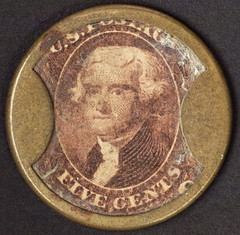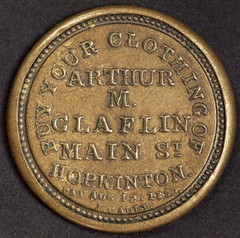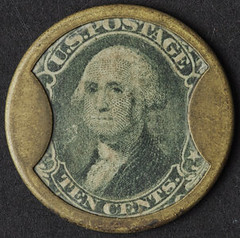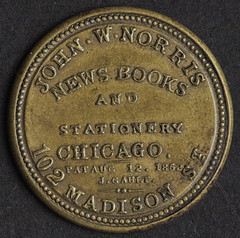
PREV ARTICLE
NEXT ARTICLE
FULL ISSUE
PREV FULL ISSUE
THE ENCASED POSTAGE STAMPAn article by Frank Clark in the Heritage April 26, 2022 Currency News email newsletter discusses one of my favorite topics: U.S. Encased Postage Stamps. -Editor A Collectibles Convergence: The Encased Postage Stamp Encased Postage is one category of collectibles where coin, stamp, and paper money collecting all intersect. Major references for all three of these collectible categories list Encased Postage. The fun and fascinating nature of these small wonders belies the historical hardship in the time of their origin. United States Encased Postage came into being as a "money of necessity" at about the same time and for many of the same reasons that ushered in the First Issue of Fractional Currency. The increased demand for metals and the economic uncertainty brought on by the Civil War caused a coin shortage due to severe hoarding of small change and resulted in the creation of this marvelous collectible. The coin hoarding spurred by the Civil War grew so problematic that by February 1862, specie brokers were quoting a premium upwards of 4.75% for gold and silver. By the time Jefferson Davis became President of the Confederate States of America on February 22, 1862, the gold and silver premium had grown to nearly 10%. At this point, even the lowly copper-nickel cents were withdrawn from circulation by the populace. The Philadelphia Mint proceeded to mint more and more copper-nickel cents. The value of the copper-nickel mixture was lower than the more-pure copper cents. Even then, the coins were hoarded in overwhelming proportions. At this point, the public turned to the only available medium at hand and began using postage stamps for their small change needs. Merchants began accepting postage stamps in their transactions since there were few alternatives. As a result, supplies of postage stamps began trading at a premium, which in turn resulted in a shortage of postage stamps to move the mail. When used for basic financial transactions, postage stamps easily became soiled or stuck to one another. Once damaged, they were useless as postage and useless as small change. This produced a plethora of other expedient ephemera for use in commerce that included paper scrip in small values, low denomination cardboard chits, merchant IOUs, and even small envelopes with advertising on the back used to contain postage stamps. At this point, entrepreneur and inventor John Gault stepped into the picture. To prevent deterioration of the stamps, Gault's solution was to enclose the postage stamps in a durable metal case with a mica "window," so that the stamp was both visible and protected from damage. Gault's profit came from initially selling the pieces to merchants. The backs of these first encasements were primarily blank save for a patent date and John Gault's name. Gault then hit upon the idea of using the back of the encasements for advertising. At the height of Gault's success, he was being commissioned to provide Encased Postage for merchants who were not retailers and therefore they did not need change. However, the merchants did see the value of advertising on the back of the encasements. Encased Postage lived a short life as the First Issue of Postage Currency (Fractional Currency) was distributed on September 8, 1862. Available stocks of the diminutive notes quickly ran out. Still, by early 1863, the National Currency Bureau (now the Bureau of Engraving and Printing) was able to print a sufficient quantity of notes so that they circulated freely. Finally, the Post Office cut off the sale of stamps for all but postage use. These two factors signaled the death knell for Encased Postage, which was likely to circulate whenever an economic crisis restricted the regular money supply. Heritage is pleased to present an advanced collection of Encased Postage of more than 50 pieces to our bidders in our upcoming Signature® Auction on May 4.
To read the complete article, see:
Wayne Homren, Editor The Numismatic Bibliomania Society is a non-profit organization promoting numismatic literature. See our web site at coinbooks.org. To submit items for publication in The E-Sylum, write to the Editor at this address: whomren@gmail.com To subscribe go to: https://my.binhost.com/lists/listinfo/esylum All Rights Reserved. NBS Home Page Contact the NBS webmaster 
|




